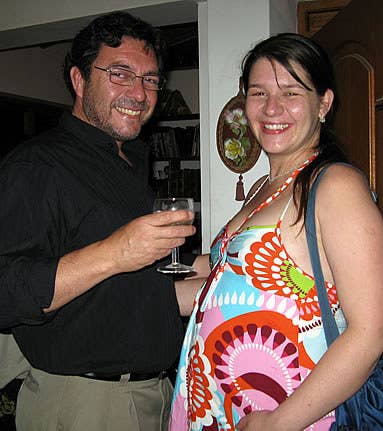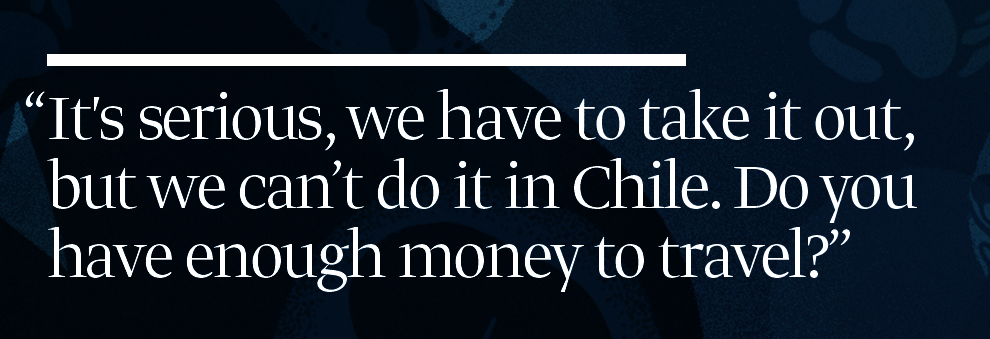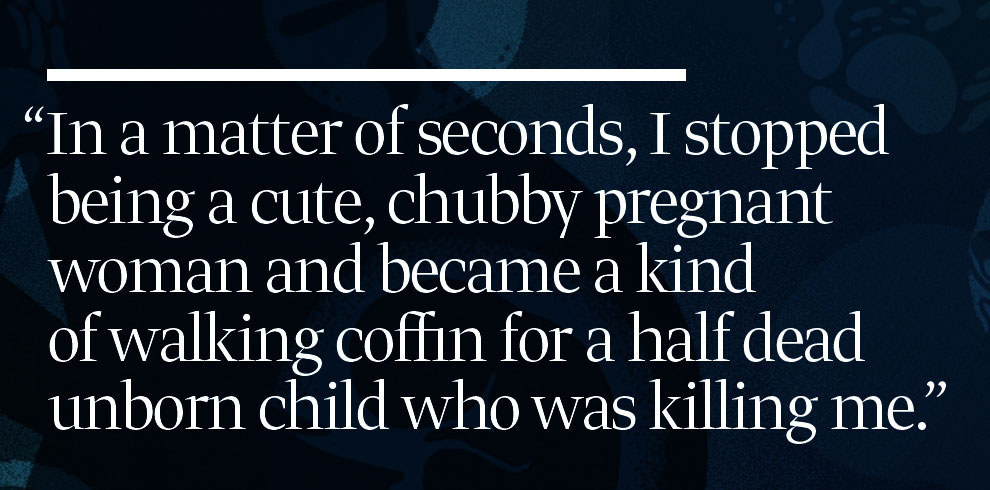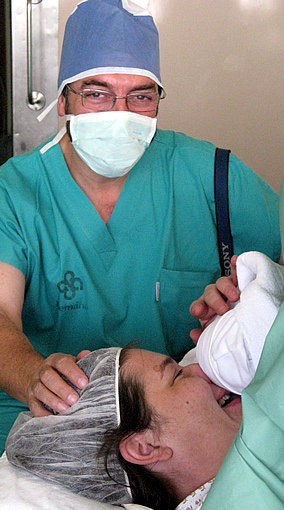Chile is one of six countries in the world where abortion is forbidden under any circumstance. It has been illegal there since 1989, when the dictator Augusto Pinochet imposed an absolute ban. A new bill advanced by Chilean President Michelle Bachelet and being debated by Chile’s lawmakers would allow abortion in cases of rape, or when the mother or the fetus’ life is at risk.
Chilean journalist Paola Dragnic found herself in the middle of the debate. You can also read this essay in Spanish.
When I was 36, all I really wanted was to have a baby. My partner Marcelo had been asking me to conceive a child for many years, but I was too busy being a workaholic reporter. It wasn't until that precise moment of my life that I felt the urge to become a mother.
The whole process of trying to get pregnant was fun and successful: after two months of trying, a pregnancy test gave us the great news. We joyfully toasted with a bottle of champagne.
It was too soon to celebrate. Now I know.
That same night, a couple of friends came over with some “ad hoc” presents, some of them so cute we laughed our heads off. It seemed unlikely that a tough feminist and independent journalist (me) would end up embracing the tacky minutiae of motherhood.
I still remember the crocheted booties Vicente gave us as a gift. They were white, he explained with his very unique sense of humor, because “since the morula is still so small, it’s impossible to know the gender.”

Back then, I had the job of my dreams: I was part of a growing investigative and interpretative journalism project, the likes of which were very rare in post-dictatorship Chile. Quite a luxury. Plus, I was earning a decent salary in an over-saturated journalism market.
But then, my pregnancy, which was supposed to be one of the happiest moments of my life, slowly began taking over my body and soul, and soon became a nightmare.
By my third week, I could not stop vomiting. I was puking up to 30 times a day. My stomach couldn't even tolerate water. And in spite of that, I swelled up grotesquely.
I knew something was dreadfully wrong. Our bodies speak to us, but we have lost the ability to listen to them, especially during pregnancy and motherhood, when we simply surrender ourselves completely in the hands of doctors.
The reality was that when I went to Dr. González, worried about my constant nausea, he told me (after the briefest of examinations) that I was an “older first-time mother.” He said that I was probably “somatizing” my symptoms — that I was vomiting more than usual in pregnancy because I was physically expressing my psychological stress. He said that all the vomiting was part of the typical hormonal changes of pregnancy.
There was no test, only the first biased judgment in a long chain of obstetric violence that would continue throughout my pregnancy.
Thus, with a linguistic slap in my face and an “older first-time mother” label, I came back home, filled with “anti-vomit” pills that didn’t make me feel better.
A couple of days went by and some heavy bleeding drove me back to the doctor. This time I was not only vomiting but also bleeding, with clear miscarriage symptoms.
The ultrasound showed a placenta detachment, but no other anomalies. I was prescribed hormone shots to preserve the pregnancy that my body was rejecting, and I was told to rest for a month in bed… with my legs elevated.
The nausea made my eyes sore. I felt numb and suffocated most of the time, and I could not stop vomiting. It was the worst nausea I’ve ever had in my whole life.
As a health reporter, I was aware of the 14th week nuchal translucency screening. It’s a common test in developed countries, but very new in Chile. It measures the amount of fluid at back of the neck of the fetus in order to screen for possible problems.
I asked my doctor to run this test on me.
Outraged, he stared at me while he held the ultrasound over my belly: “How do you know about that, huh?... You’re not planning to abort if there’s something wrong, are you?”
His reaction was so brutally harsh that I realized that the pregnancy was not mine but his, and that I wouldn't know for certain what was going on.
I hadn’t reached the 14th week of pregnancy, and my physical condition was dismal. I had gained more than 65 pounds and none of my shoes would fit me — the liquid retention alone could have killed me.
“How do you know about that, huh?... You’re not planning to abort if there’s something wrong, are you?”
I was terrified, but also sure that something was going very wrong. I called my brother, who is a pediatrician, and asked him to help me find an expert in fetal medicine. This new doctor got us the best 4D ultrasound machine so that we could enjoy the session and eliminate our doubts. But it didn’t go as we had hoped.
If the nuchal translucency result is more than 2 millimeters, there is a high risk of health problems with the fetus. The nuchal translucency in my case was abysmal.
Three days later, we came back to the doctor, and this time we had no doubts: the measurement was about 9 millimeters. The new doctor spent about 20 minutes measuring my belly as much as he could.
Back in his office, pencil in hand, he explained: “This means the fetus has some kind of problem. Most of the times, nuchal translucency is caused by Down Syndrome, but in this case I can rule that out, since the fetus has a nasal bone.” The doctor thought there could be some heart malformation that could be fixed in utero, or when the baby was born. Then I asked him for a genetic test.
Amniocentesis (the extraction of amniotic liquid) can only be performed after six months of pregnancy, so we chose the “chorionic villi” test: they punctured my belly to extract material from the placenta, analyzing its genetic composition.
The procedure involved a risk of abortion, but I was sure that wouldn't happen, and I was also positive that the results would be as bad as I expected.
The test took a couple of days, and we were asked to pick up the results in person. I told my brother in advance that it must be a case of triploidy. As a journalist, I had been doing my own research on my condition while the doctors were trying to diagnose me.
Back in 2006, none of us had smartphones, so we went to an internet café to search for clues online. We typed in the term “triploidy.” Sitting on three different computers, my brother, my husband and I started reading: “The patient could die,” “it could generate an invasive mole,” “it could unleash a kind of cancer that can easily metastasize.”
Broken and confused, we headed straight to the clinic. The doctor confirmed that it was triploidy and told us: “It’s serious, we have to take it out, but we can’t do it in Chile. Do you have enough money to travel?”

Marcelo and I stared at one another. The answer had to be yes, even though we were broke.
So I had two overwhelming things to add to my unbearable physical state: I was not going to be a mother, and I was going to die if I didn’t leave the country to abort my pregnancy.
It's taken this long for me to be able to talk about the degree of violence I had to endure, especially from the Chilean government. In a matter of seconds, I stopped being a cute, chubby pregnant woman and became a kind of walking coffin for a half-dead unborn child who was killing me.
If all this grief and horror wasn't enough, I had to figure out how to get an abortion in order to save my uterus and my life.
The doctor explained all the details about the “genetic mistake” that had happened, several times. Most people usually have two copies of each chromosome, but my fetus had three.
This genetic anomaly brought about such a lethal disorder in my body that the placenta quickly filled with tumors that grew in number and size (“as big as grapes”), and my hormone levels spiked violently.
“That’s why you are going from bad to worse. It's like you’re having 10 pregnancies for the level of hormones you have,” the doctor said. That was the feeling I described for weeks, but no one seemed to acknowledge this as a valid symptom.
Thus began an odyssey no woman should have to endure, because the need and will to have a medically necessary abortion can’t turn someone who was going to be a mother into a criminal.
Faced with our despair and the impotence of Chilean doctors, our physician made a phone call to Tampa, Florida. In perfect English, he told the doctor on the other end of the line that he had a case of a very severe triploidy, and that he wanted to refer me there.
Without a valid visa to visit the United States, and with little money in our pockets, we started to pull every string we could. The U.S. Embassy in Chile helped a lot, and friends and family who knew about our situation lent us some money.
In the meantime, I wasn’t able to grieve or to be sad. I could hardly walk, see or hear. I just dragged myself from one place to another, filling out the necessary paperwork and, of course, vomiting.
Every two days I underwent an ultrasound to check the degree of invasion of the tumors and the condition of the fetus. It was almost crushed, but still alive. What were the doctors waiting for? For the fetus to die so they would not have legal trouble. For me to travel overseas. Or for my life to be at absolutely at risk, so they would have an indisputable reason to “save me.”

The Chilean government was torturing me. It was risking my life by denying my right to an emergency health procedure. What scared me the most was the risk of losing my uterus altogether. In a situation this extreme, many times they perform a hysterectomy in order to prevent the growths and tumors from spreading to the rest of your body.
In the midst of it all, I sat in a coffee shop, and a woman apologized for lighting a cigarette near me without realizing I was pregnant. “It’s just fat,” I lied.
As I walked away I couldn’t help crying my eyes out, telling myself that I would inform everyone about what was happening to me. One by one, I reached out to all my friends, and they replied back to my emails. I was surprised that even my mother in law — a self-proclaimed anti-abortionist who is very religious and a part of the most conservative right wing of Chile — paid special attention to the truth and the absolute need for Chile to pass a bill that would allow abortions when the mother’s life or health is at risk.
I wanted to sue the government over my situation, but the feminist NGOs I approached to do this wouldn’t dare to help me. I collapsed in some kind of shock. An ambulance took me to the emergency room of the clinic.
When the doctor showed up, he explained that the latest blood test exhibited abnormal hormonal levels, and that my condition was lethal.
He told me that the clinic's Ethics Committee had authorized him to do whatever it took to save me, adding, “we may have to do a couple of chemotherapies, but they'll be mild, don’t worry, you won't lose your hair,” as if anyone would even care about hair in a moment like this.
WIthout a single warning, a nurse put a little pill inside my vagina. In 20 minutes, I felt like I was breaking apart. The contractions were so brutal I couldn't even breathe. My heart was pounding so violently that I felt an acute pain all over my body. They were forcing me to expel the contents of my uterus, without preparing me for it.
“Do I still have a uterus?”
All of the sudden, I felt my water break, and amniotic fluid began falling. That's when I finally lost control and gave in to rage. I had been tortured for four and a half months, and now they were trying to make me give birth in a natural way, to stage some miscarriage or who knows what.
Out of control, taken over by anger, I yelled at them. “Don't you make me give birth motherfuckers, I will not be a mother. Don’t do this to me. I will call the police, you sons of bitches, put me under now,” I screamed, while the room filled with health staff and I straightened my arm, demanding general anesthesia.
I was four and a half months into that deadly pregnancy, and I was in one of Chile's best private clinics.
Everything fell apart at that precise moment. I suddenly noticed the lights of the operating room, and the mask over my face. I don’t know how much time went by, but when I woke up, a nurse was caressing my cheek and the doctor by my side whispered, “It's all over, stay calm.”
I could hardly utter a word. As soon as I managed to moisten my lips, my tongue still clumsy from the anesthesia, I asked the nurse about my greatest fear: “Do I still have a uterus?”
I did.
Two thick tears rolled over my cheeks. I closed my eyes and sighed deeper than I ever had, feeling the strongest relief I have ever experienced: It was all over.

Later that afternoon, the nurse broke the rules and allowed me to smoke a cigarette, hiding on the balcony of my room. Wrapped in that unflattering robe, the same you get in any hospital, whether poor or rich, I crossed my legs, attempting to regain my dignity. I sat back in my wheelchair and, as if I were in the Caribbean, I took a drag of the cigarette that marked the end of that nightmare.
A year later, after having blood tests and an ultrasound every Friday to check whether I was back to normal, we put this worn out but strong uterus back to use, and 9 months later I gave birth to little Sofía, 20.5 inches and 6 pounds, 34 ounces. Today she is 7 years old, and she knows perfectly well that her mom had another pregnancy before her, but it didn't work so they had to end it. “That’s what all the interviews are all about, right Mom?” she asks every time a fellow reporter wants to talk about it.
Someday, Sofía will be a woman like me, and I don't want her, or any other woman, to be tortured by a deaf government that makes us suffer in the name of a false morality.
Two years later, I got pregnant again, and that time it was our dear Simón Nicolás, who is 4 years old now. All thanks to an abortion that allowed me to be a mother.
